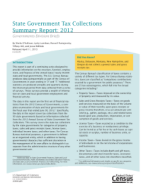State Government Tax Collections Summary Report: 2012
State Government Tax Collections Summary Report: 2012
Introduction
This report is part of a continuing series designed to provide information on the structure, function, employment, and finances of the United States’ nearly 90,000 state and local governments. The U.S. Census Bureau produces data quinquennially as part of the Census of Governments in years ending in “2” and “7.” Additional statistics are produced annually and quarterly during the intercensal period from data collected from a series of surveys. These surveys provide a wealth of information on state and local government employment and financial activity.
The data in this report are the first set of financial statistics from the 2012 Census of Governments, a complete enumeration of state and local governments for the fiscal year that ended June 30, 2012. Specifically, the data in this report cover tax collections from the 50 state governments based on information collected from the 2012 Annual Survey of State Government Tax Collections. This survey covers the state tax collections by the state governments for categories of property taxes, sales and gross receipts taxes, license taxes, individual income taxes, and other taxes. For Census Bureau statistical purposes, a government is defined as an organized entity, which in addition to having governmental character, has sufficient discretion in the management of its own affairs to distinguish it as separate from the administrative structure of any other governmental unit.
The Census Bureau’s classification of taxes contains a variety of different tax types. For Census Bureau statistics, taxes are classified as “compulsory contributions exacted by a government for public purposes.” There are 25 tax subcategories, which fall into five broad categories including:
• Property Taxes—Taxes imposed on the ownershipof property and measured by its value.
• Sales and Gross Receipts Taxes—Taxes on goodsand services measured on the basis of the volumeor value of their transfer, upon gross receipts orgross income therefrom, or as an amount per unitsold (e.g., gallon, package, etc.); and related taxesbased upon use, production, importation, or consumption of goods and services.
• License Taxes—Taxes exacted as a condition to theexercise of a business or nonbusiness privilege.Can be levied as a flat fee or by such bases as capital stock or surplus, number of business units, orcapacity.
• Income Taxes—Taxes levied on the gross incomeof individuals or on the net income of corporationsand businesses.
• Other Taxes—Taxes include death and gift taxes,documentary and stock transfer taxes, severancetaxes, and all other taxes not elsewhere classified.
Data in this report refer to a state government’s 2012 fiscal year. Forty-six of the fifty state governments have a fiscal year that runs from July 1, 2011, to June 30, 2012. However, four state governments are exceptions to the June 30 fiscal year end date—Alabama and Michigan (September 30), New York (March 31), and Texas (August 31). Tax receipts are measured over the course of the fiscal year and represent total amounts received for that year.




